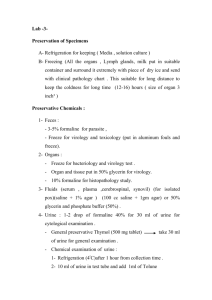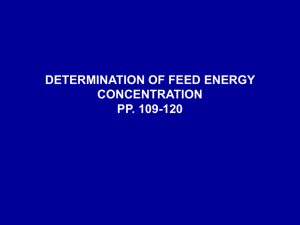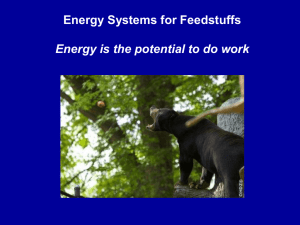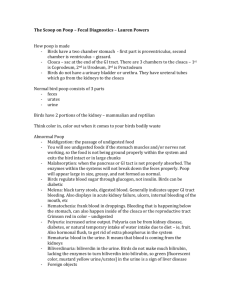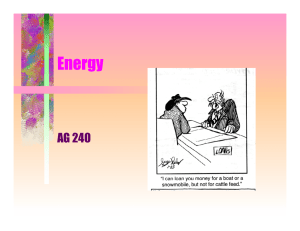Energy
advertisement
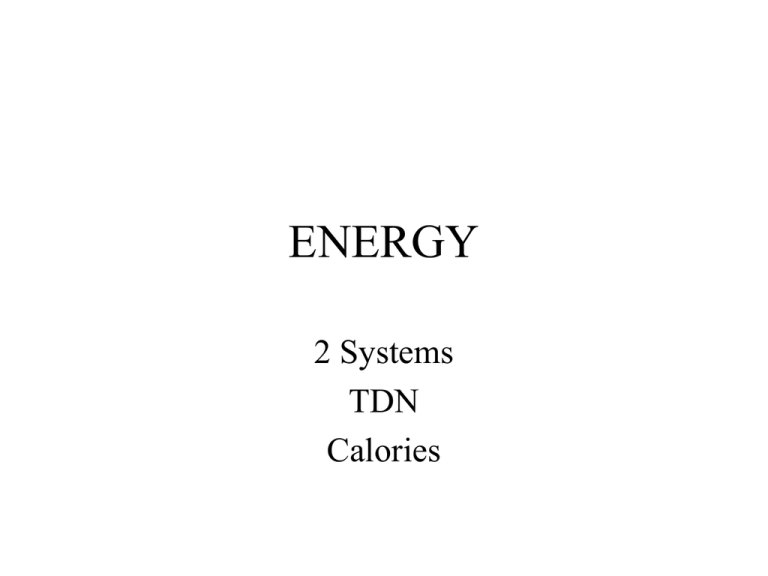
ENERGY 2 Systems TDN Calories GROSS ENERGY GROSS ENERGY Feces GROSS ENERGY Feces DIGESTIBLE ENERGY GROSS ENERGY Feces DIGESTIBLE ENERGY Urine & Gas GROSS ENERGY Feces DIGESTIBLE ENERGY Urine & Gas METABOLIZABLE ENERGY GROSS ENERGY Feces DIGESTIBLE ENERGY Urine & Gas METABOLIZABLE ENERGY Heat increment GROSS ENERGY Feces DIGESTIBLE ENERGY Urine & Gas METABOLIZABLE ENERGY Heat increment NET ENERGY GROSS ENERGY Feces DIGESTIBLE ENERGY Urine & Gas METABOLIZABLE ENERGY Heat increment NET ENERGY Maintenance Gain Reproduction Milk Production Gross Energy includes all the energy in a feed. •It is not all available to the animal •It is determined by how much heat is liberated upon combustion. Digestible Energy is how much energy does not end up in the feces. •Therefore it was absorbed. •It is not all used by the animal, some is lost. Metabolizable Energy is what is left after accounting for energy in feces, urine and gasses. •It is still not all available for the animal to use. Net Energy • Is what is left after accounting for losses to feces, urine & gasses and heat increment. – Heat increment is energy lost in fermentation and in metabolic processes. • Net Energy is available for the animal to use. • It is not used with the same efficiency for all processes. • Net Energy is always used most efficiently for maintenance. • Milk production is almost as efficient as maintenance. • Gain (growth and fattening) is less efficient. • Different uses for energy require different values be used for the energy content of feeds for each purpose. • Maintenance needs must always be met first • This complicates ration balancing. GROSS ENERGY Feces DIGESTIBLE ENERGY Urine & Gas METABOLIZABLE ENERGY Heat increment NET ENERGY Maintenance Gain Reproduction Milk Production Determining Caloric Energy • Use Paar Adiabatic Bomb Calorimeter Steps in determining calories • • • • • • Prepare sample (grind, pellet, place in bomb) Wire bomb and charge with Oxygen Place in calorimeter in known amount of H2O Measure initial temperature Ignite Measure final temperature Calculations • 1 calorie = energy to raise 1 g H2O 1° C • 1000 cal = 1 Kcal – (In humans 1 Calorie = 1 Kcal, animal nutritionists don’t use Calorie vs calorie) • Temp rise X g H2O = calories in sample • Cal in sample X amount of feed = Cal in feed – same for feces • Calculate the total calories (or Kcal) (per day) eaten and excreted (in feces, urine). • Calculate DE, ME, Net E (must know the endogenous contribution in Kcal/Kg and % – For Kcal/Kg divide the Kcal of interest by Kg consumed – For %, divide the Kcal of interest by Kcal of feed consumed (times 100). TDN • Total Digestible Nutrients – Forget that, I consider it a misnomer – It is really: • An ENERGY INDEX on a carbohydrate equivalent basis • Calculated from proximate analysis Calculating TDN • • • • • • % CP X Digestibility = x % EE X 2.25 X Digestibility = x % CF X Digestibility =x % NFE X Digestibility =x -----SUM = TDN TDN Example • • • • • • Water Nitrogen Ether Extract Crude Fiber Ash NFE 12 2 4 10 2 Example • • • • • • Water 12 Nitrogen 2 (2*6.25) 12.5 Ether Extract 4 Crude Fiber 10 Ash 2 NFE Example • • • • • • Water 12 Nitrogen 2 (2*6.25) 12.5 Ether Extract 4 Crude Fiber 10 Ash 2 NFE 59.5 Example digestibility • • • • • • Water 12 Nitrogen 2 (2*6.25) 12.5 Ether Extract 4 Crude Fiber 10 Ash 2 NFE 59.5 .80 .75 .40 .80 Example digestibility • • • • • • Water 12 Nitrogen 2 (2*6.25) 12.5 .80 = 10 Ether Extract 4 * 2.25 * .75 =6.75 Crude Fiber 10 .40 = 4 Ash 2 NFE 59.5 .80 = 47.6 • • TOTAL (TDN) ----------------- 68.35
